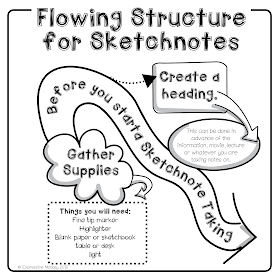Before you start sketchnote taking, it's important to think about which visual structure you will use. Each structure has advantages and will work best for different kinds of information.
The flowing structure works best for a sequence of events, functioning like a timeline.
The flowing structure also works for information that branches out like the branches of a tree.
The information in this graphic (above) also gives you some tips on what to do to get ready to take sketchnotes.
The modular structure works best for containing different topics. Connectors can be added to show how information in one frame or container connects to another area.
The information in this graphic (above) also talks about the advantages of adding visuals to sketchnotes.
The vertical structure for sketchnote taking is good to use when the information can be divided into 2 or more categories. Some people might prefer this type of sketchnote taking because it appears more orderly.
The information in this graphic (above) talks about how you can convey emotions in your stick figures by using body language, lines, and symbols.
The web structure for sketchnote taking works great when you are brainstorming or starting with a central idea and generating ideas that stem from the central idea or topic.
Connectors can show how the information can connect to other ideas.
The information is this graphic (above) talks about the most important part of sketchnotes is conveying information. The quote "ideas not art" is repeated in several blogs across the internet. Although sketchnotes can by very visually interesting. People should not be intimidated by their (perceived) lack of artistic skills. If you can draw stick figures, arrows, boxes and other simple shapes, you and put sketchnotes into use. The more you take sketchnotes, the more you will build your visual vocabulary to include other symbols and shapes that you access from your visual memory bank.
I've created a Sketchnotes Toolbox full of ideas that you can use to get more ideas. If you would like a free high-quality copy of the images in this blog you can get them in my Sketchnotes Graphic Images.
If you'd like some Tips for Teaching with Sketchnotes, then check out my other blog post on Art with Jenny K's blog.
References
I found these blogs helpful when researching sketchnotes.
This blog post by Core 77 gives practical information about getting started.
This blog post and Prezi created by Derek Bruff will show you a few more examples of Sketch Notes and why they are better than traditional note taking.




No comments:
Post a Comment